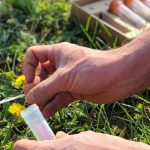
Tag Archives Soil biology

Measuring the components of healthy soil in Alberta
Part 1 of 2: Soil health more than just its chemical properties, according to the Alberta Soil Health Benchmark Report

Demystifying biological inputs
A new partnership brings science-based field data to ag input listings to help growers sort fact from fiction

One does not simply measure soil health
Agronomy Management: Just analyzing soil samples won’t give you the big picture

Crop residues’ rewards versus risks
Leaving crop residue after harvest can be beneficial — but poses some challenges

Fall-applied nitrogen and nitrogen stabilizers
Keep your nitrogen in the soil where plants need it

Why soybeans need inoculant and how some crops fix nitrogen without it
Plus, never do this with inoculant

Canada’s OYF: Nominees from Saskatchewan
Derek and Tannis Axten focus on encouraging soil biology

Promise of self-fertilizing attracts investment
Bayer bets big on a future where crops are designed to fertilizer themselves

New bacteria enhance N-fixing performance
Natural soil molecules recruited to help increase pulse crop growth and yield

Beneficial bacteria getting close
New products may promote plant growth and protect crops from disease


